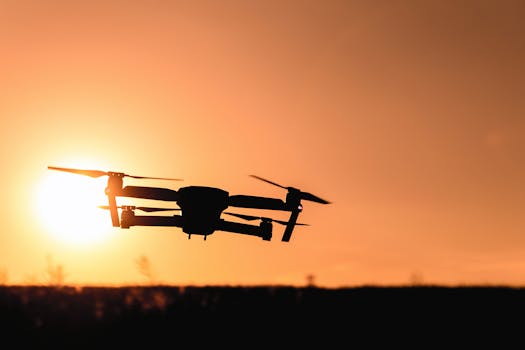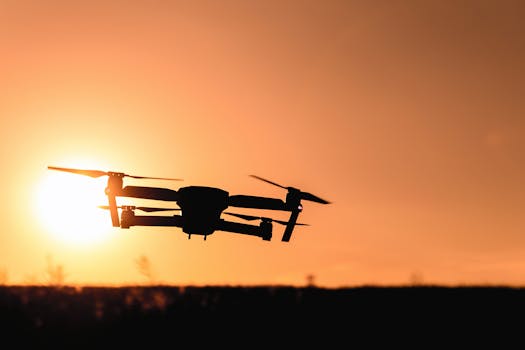Top 10 Drones for Aerial Photography and Videography in 2025: A Comprehensive Review
As aerial photography and videography continue to evolve, the demand for high-performance drones has surged, especially among professionals and enthusiasts seeking cinematic-quality footage. In 2025, the market is brimming with advanced models that offer exceptional image quality, intelligent flight features, and robust build quality. This comprehensive review explores the top 10 drones that stand out in the realm of aerial imaging, each offering unique capabilities tailored to a variety of creative and professional needs.
Leading the list is the DJI Inspire 3, a flagship model designed for professional cinematographers. With its full-frame 8K camera, dual-operator control, and RTK positioning system, the Inspire 3 delivers unparalleled precision and image fidelity. Its advanced obstacle avoidance and extended flight time make it a top choice for high-end productions. Closely following is the Autel Robotics EVO Max 4T, which impresses with its 6K camera, thermal imaging capabilities, and AI-powered tracking. This drone is particularly suited for industrial applications and creative projects requiring detailed visual data.
Next, the DJI Mavic 3 Pro continues to dominate the consumer and prosumer market. Featuring a triple-camera system, including a Hasselblad 4/3 CMOS sensor, it offers stunning dynamic range and color accuracy. Its compact design and intelligent flight modes, such as ActiveTrack 5.0 and MasterShots, make it ideal for solo creators and travel filmmakers. Similarly, the Skydio X10 stands out for its autonomous flight capabilities. Equipped with six 4K navigation cameras and a 50MP main sensor, it excels in complex environments where manual piloting is challenging.
Transitioning to more compact options, the DJI Air 3 offers a balanced mix of performance and portability. With dual cameras—a wide-angle and a 3x telephoto—it provides creative flexibility without compromising image quality. Its 46-minute flight time and omnidirectional obstacle sensing enhance both safety and productivity. Meanwhile, the Parrot Anafi AI introduces 4G connectivity for uninterrupted control and real-time data transmission, making it a strong contender for mapping and inspection tasks.
For those seeking affordability without sacrificing quality, the Holy Stone HS720G offers 4K video, GPS-assisted flight, and a user-friendly interface. While it may not match the high-end models in terms of features, it remains a solid entry-level option for hobbyists. In a similar vein, the Potensic Dreamer Pro 4K provides a stabilized 3-axis gimbal and a Sony sensor, delivering impressive results for its price point.
Rounding out the list are two specialized drones: the Freefly Astro and the Sony Airpeak S1. The Freefly Astro is tailored for industrial and mapping applications, boasting a modular design and compatibility with a range of payloads. Its precision and reliability make it a favorite among surveyors and engineers. On the other hand, the Sony Airpeak S1 is engineered for professional filmmakers using Sony Alpha cameras. With its high-speed performance and seamless integration with Sony’s imaging ecosystem, it offers unmatched creative control.
In conclusion, the top drones of 2025 reflect significant advancements in imaging technology, flight intelligence, and user experience. Whether for cinematic storytelling, industrial inspection, or recreational use, these models represent the pinnacle of aerial photography and videography tools available today.
Best Drones of 2025 for Capturing Stunning Aerial Shots

As aerial photography and videography continue to evolve, the demand for high-performance drones equipped with advanced imaging capabilities has surged. In 2025, the market offers a wide array of drones tailored to both professional filmmakers and hobbyists seeking to capture breathtaking aerial shots. The best drones of the year combine cutting-edge camera technology, intelligent flight features, and robust build quality, making them indispensable tools for visual storytellers.
Leading the pack is the DJI Inspire 3, a flagship model designed for cinematic excellence. With its full-frame 8K camera and dual-operator control system, it provides unmatched image quality and precision. Its advanced obstacle avoidance and extended flight time make it ideal for complex shoots in dynamic environments. Closely following is the Autel Robotics EVO Max 8T, which boasts a 6K camera with a large sensor and AI-powered subject tracking. This drone is particularly favored for its versatility and user-friendly interface, making it suitable for both seasoned professionals and ambitious beginners.
Another standout is the Skydio X10, renowned for its autonomous flight capabilities. Utilizing advanced AI and 360-degree obstacle detection, it allows users to focus entirely on composition while the drone handles navigation. Its 4K HDR camera ensures vibrant, detailed footage even in challenging lighting conditions. Meanwhile, the DJI Air 3 has emerged as a top choice for enthusiasts seeking a balance between performance and portability. Featuring dual cameras—a wide-angle and a telephoto lens—it offers creative flexibility without compromising image quality.
For those prioritizing compactness without sacrificing functionality, the Parrot Anafi AI is a compelling option. This drone integrates 4G connectivity for extended range and real-time data transmission, along with a 48MP camera capable of capturing high-resolution stills and 4K video. Its lightweight design and foldable frame make it an excellent companion for travel and on-the-go shooting.
In the realm of affordability, the Holy Stone HS720G stands out. While it may not match the high-end models in terms of specs, it delivers impressive 2K video quality and GPS-assisted flight at a fraction of the cost. This makes it an ideal entry-level drone for aspiring aerial photographers. Similarly, the Potensic Dreamer Pro 4K offers a solid feature set, including a 3-axis gimbal and 4K camera, catering to users who want professional-looking footage without a steep learning curve.
The Yuneec Typhoon H3, developed in collaboration with Leica, is another noteworthy contender. Its 1-inch sensor and six-rotor design provide stability and clarity, even in windy conditions. This drone is particularly well-suited for high-end commercial projects where image fidelity is paramount. Additionally, the Freefly Astro stands out in the professional sector with its modular design and compatibility with cinema-grade cameras, offering unparalleled customization for complex productions.
Rounding out the list is the DJI Mini 4 Pro, a lightweight yet powerful drone that complies with most global drone regulations due to its sub-250g weight. Despite its small size, it features a 1/1.3-inch sensor, 4K video, and advanced flight modes, making it a favorite among content creators who need a discreet yet capable flying camera.
Altogether, the top drones of 2025 reflect significant advancements in aerial imaging technology. Whether you’re capturing sweeping landscapes, dynamic action scenes, or intricate architectural details, these drones offer the tools necessary to elevate your creative vision from the ground to the sky.
2025 Drone Buyer’s Guide: Top 10 Picks for Photography and Videography
As drone technology continues to evolve, 2025 brings a new wave of advanced aerial photography and videography tools that cater to both professionals and enthusiasts. With enhanced imaging capabilities, longer flight times, and smarter autonomous features, the latest drones offer unprecedented creative potential. Choosing the right model, however, can be a daunting task given the variety of options available. To assist in this decision-making process, we have compiled a list of the top 10 drones for aerial photography and videography in 2025, based on performance, camera quality, flight stability, and user experience.
Leading the pack is the DJI Inspire 3, a flagship model designed for cinematic production. It features a full-frame 8K camera, dual-operator control, and RTK positioning for precise navigation. Its robust build and professional-grade features make it ideal for filmmakers seeking uncompromising image quality. Closely following is the Autel Robotics EVO Max 8T, which boasts a 6K camera with a 1-inch CMOS sensor and advanced obstacle avoidance. Its modular design and AI-powered flight modes provide flexibility for various shooting scenarios.
For those looking for a balance between performance and portability, the DJI Air 3 stands out. Equipped with dual cameras—a wide-angle and a 3x telephoto—it offers creative versatility in a compact form. Its 46-minute flight time and omnidirectional obstacle sensing make it a reliable choice for travel and landscape photography. Similarly, the Skydio X10 impresses with its autonomous flight capabilities and 4K HDR camera. Built with AI-driven navigation, it excels in complex environments where manual control may be challenging.
Another strong contender is the Parrot Anafi AI, which integrates 4G connectivity for extended range and real-time data transmission. Its 48MP camera and 6-axis hybrid stabilization ensure crisp, stable footage even in windy conditions. Meanwhile, the DJI Mavic 3 Pro continues to be a favorite among content creators, thanks to its triple-camera system, including a Hasselblad main sensor and two telephoto lenses. This setup allows for dynamic framing and cinematic zoom effects.
For budget-conscious users, the Holy Stone HS900 offers a compelling package with a 4K camera, GPS-assisted flight, and intelligent return-to-home features. While it may not match the high-end models in image quality, it provides excellent value for beginners and hobbyists. The Hubsan Zino Mini Pro also deserves mention, offering 4K video, a 1/1.3-inch sensor, and a lightweight design under 250 grams, making it ideal for casual users who prioritize portability without sacrificing quality.
Rounding out the list are the Yuneec Typhoon H3 and the PowerVision PowerEgg X. The Typhoon H3, developed in partnership with Leica, delivers exceptional color accuracy and image detail, making it suitable for professional photography. On the other hand, the PowerEgg X doubles as a handheld camera and features waterproof housing, making it versatile for both aerial and ground-level shooting.
In conclusion, the drone market in 2025 offers a diverse range of options tailored to different needs and budgets. Whether you’re a seasoned filmmaker or an aspiring aerial photographer, these top 10 drones provide the tools necessary to capture stunning visuals from above. By considering factors such as camera specifications, flight performance, and ease of use, buyers can make informed decisions that align with their creative goals.



